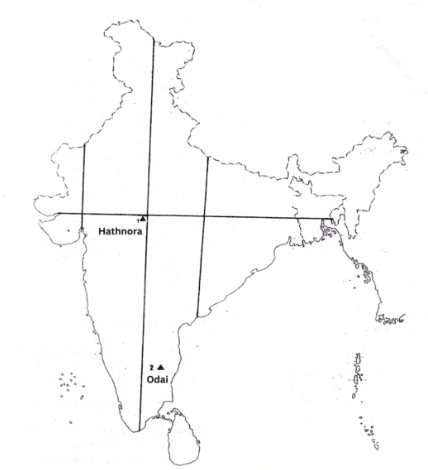UPSC Exam > UPSC Notes > History Optional for UPSC > Petroglyph Sites
Petroglyph Sites | History Optional for UPSC PDF Download
Hominid Fossil Record
- The hominid fossil record is one of the best and most complete among mammals.
- The oldest fossil hominid in South Asia is an archaic Homo sapiens found in Hathnora, located on the Narmada River, near the well-known paleolithic site at Hoshangabad.
Hominid Fossil Sites
Hathnora
A village on the northern bank of the Narmada River in the Sehore district of Madhya Pradesh.- A fossilized fragment of a skull cap, along with some vertebrate fossils and Acheulian tools, was discovered by Arun Sonakia.
- The skull fragment belonged to a 30-year-old woman representing an advanced variety of Homo erectus.
- A hominid clavicle (collar bone), along with animal fossils and Paleolithic tools, was found by A. R. Sankhyan.
- Two sets of human fossils found may belong to the same woman.
- Estimated dates: 0.5 to 0.2 million years ago.
Odai
Location and Discovery:- The fossilized human baby skull was found in the Villupuram district of Tamil Nadu by P. Rajendran.
- Rajendran was excavating a trench that contained microliths (small stone tools) in the upper layers and Upper Paleolithic tools in the lower layers.
Age and Significance of the Skull:
- The skull is dated to the middle or upper Pleistocene epoch, approximately 166,000 years ago.
- This discovery marks the first-ever finding of a human fossil within ferricrete, a type of soil cemented by iron.
Pune
In Pune district, Maharashtra.- Two human mandibles of an adult male and female Homo sapiens found by H. D. Sankalia and S. N. Rajaguru on the bank of the Mula-Mutha river.
- Its age is uncertain.
Bhimbetka
In Raisen district, Madhya Pradesh:Discovery: An adult male skeleton was found by V. S. Wakankar in a cave at Bhimbetka. Age: The age of the skeleton is uncertain.
The document Petroglyph Sites | History Optional for UPSC is a part of the UPSC Course History Optional for UPSC.
All you need of UPSC at this link: UPSC
|
367 videos|995 docs
|
FAQs on Petroglyph Sites - History Optional for UPSC
| 1. What are the key characteristics of hominid fossils that help in understanding human evolution? |  |
Ans. Hominid fossils exhibit several key characteristics that are crucial for understanding human evolution. These include changes in skull shape, particularly the size and structure of the braincase, which indicate increases in brain size over time. Bipedalism is another significant trait, evidenced by the structure of the pelvis and leg bones, which shows adaptations for walking upright. Additionally, dental morphology, such as tooth size and arrangement, provides insights into diet and the evolutionary adaptations to different environmental conditions.
| 2. Where are the most significant hominid fossil sites located around the world? |  |
Ans. Some of the most significant hominid fossil sites include the East African Rift Valley, particularly in countries like Kenya and Ethiopia, where many crucial fossils, such as "Lucy" (Australopithecus afarensis), have been found. Other important sites include the Olduvai Gorge in Tanzania, which has yielded numerous ancient tools and hominid remains, and the caves of South Africa, where early Homo species fossils have been discovered. Additionally, sites in Asia and Europe, such as the Zhoukoudian in China and La Chapelle-aux-Saints in France, are also vital for studying hominid evolution.
| 3. What role do petroglyph sites play in understanding early human culture? |  |
Ans. Petroglyph sites, which are rock carvings made by prehistoric peoples, provide valuable insights into early human culture and societal structures. These carvings often depict animals, human figures, and symbolic motifs, reflecting the beliefs, rituals, and daily activities of ancient communities. By studying these sites, researchers can gain a better understanding of the cognitive and artistic abilities of early humans, as well as their relationship with the environment and each other. Such insights contribute to a broader understanding of human evolution and cultural development.
| 4. How do scientists date hominid fossils and archaeological sites? |  |
Ans. Scientists utilize several dating methods to determine the age of hominid fossils and archaeological sites. Radiometric dating techniques, such as carbon-14 dating, are commonly used for organic materials up to about 50,000 years old. For older fossils, methods such as potassium-argon dating and uranium-series dating are employed. Stratigraphy, the study of rock layers, allows scientists to establish a relative timeline by examining the sequence of deposits. Additionally, thermoluminescence and optically stimulated luminescence are used to date sediments associated with archaeological finds.
| 5. What are the implications of discovering new hominid fossils for our understanding of human ancestry? |  |
Ans. The discovery of new hominid fossils can have profound implications for our understanding of human ancestry. New findings can challenge existing theories about human evolution, including the timeline and pathways of migration. For instance, the discovery of previously unknown species may suggest that the human family tree is more complex than previously thought, with multiple hominid species coexisting and possibly interbreeding. These discoveries can also provide insights into the adaptations and behaviors of early humans, enhancing our understanding of how modern humans developed and adapted over time.
Related Searches















